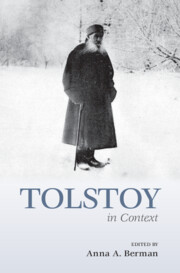Book contents
- Tolstoy in Context
- Tolstoy in Context
- Copyright page
- Contents
- Figures
- Notes on Contributors
- Preface
- Acknowledgments
- Note on Citations, Translations, and Transliterations
- Chronology
- Part I The Man
- Part II Russian Social and Political Contexts
- Part III Literature, the Arts, and Intellectual Life
- Part IV Science and Technology
- Part V Beyond Russia
- Part VI Tolstoy’s Afterlife
- Chapter 34 Tolstoy’s Complete Works
- Chapter 35 Tolstoy in English Translation
- Chapter 36 Film Adaptations
- Chapter 37 Musical Adaptations
- Chapter 38 Biographies
- Chapter 39 Tolstoy as the Subject of Art: Painting, Film, Theater
- Suggested Further Reading
- Index
Chapter 39 - Tolstoy as the Subject of Art: Painting, Film, Theater
from Part VI - Tolstoy’s Afterlife
Published online by Cambridge University Press: 05 January 2023
- Tolstoy in Context
- Tolstoy in Context
- Copyright page
- Contents
- Figures
- Notes on Contributors
- Preface
- Acknowledgments
- Note on Citations, Translations, and Transliterations
- Chronology
- Part I The Man
- Part II Russian Social and Political Contexts
- Part III Literature, the Arts, and Intellectual Life
- Part IV Science and Technology
- Part V Beyond Russia
- Part VI Tolstoy’s Afterlife
- Chapter 34 Tolstoy’s Complete Works
- Chapter 35 Tolstoy in English Translation
- Chapter 36 Film Adaptations
- Chapter 37 Musical Adaptations
- Chapter 38 Biographies
- Chapter 39 Tolstoy as the Subject of Art: Painting, Film, Theater
- Suggested Further Reading
- Index
Summary
When Lev Tolstoy died in 1910, he was a literary celebrity, famous well beyond the borders of his native Russia. His death became one of the first truly international media events of the twentieth century. But the public hunger for images of the great man was already prominent much earlier in his life, when both commissioned and unsolicited portraits and photographs proliferated, creating an international Tolstoy iconography. Throughout the twentieth century, artists, filmmakers, and writers attempted to create their own vision of Tolstoy, either embracing or opposing, but always engaging with, this visual canon. This chapter discusses Tolstoy as a subject of art in painting, cinema, and the theatre, exploring the impact of celebrity-generated images on his representation in these media. First, it focuses on well-known portraits and sculptures of Tolstoy, from Ilya Repin’s famous paintings to Oleg Kulik’s playful installations, as well as controversial frescoes and advertising images. It then moves on to chart a very short history of Tolstoy’s appearance on film, first as a celebrity and then as a character. The final part of the chapter discusses Tolstoy’s postmodern afterlives in the works of Viktor Pelevin and in contemporary Russian theatre.
Keywords
- Type
- Chapter
- Information
- Tolstoy in Context , pp. 323 - 335Publisher: Cambridge University PressPrint publication year: 2022

